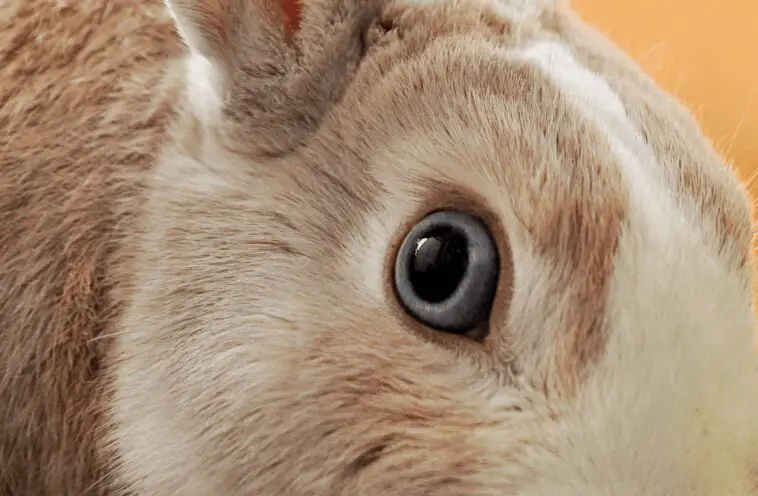Like other species, the eye is one of the important senses for your rabbit. They get to grasp the things happening in their surroundings by looking at them. It’s also easier for your pet to react whenever they are in danger, or there are threats nearby.
That is why it’s important to understand the function of your rabbit’s eye and the common infection that can happen to them so that you can avoid health issues concerning their vision.
According to the Winter Park Veterinary Hospital, the eye of the rabbit is more sensitive than the other because they only have one opening in their eyelid, and their eyes are placed near the molar and tooth roots. Therefore, there is a chance that eyes and dental problems can be interconnected, considering the distance between the two.
Rabbit Eyes
The rabbit’s eyes are positioned on two opposite sides of its head. This helps and allows them to see what is around them. However, according to the report, rabbits’ vision is disadvantaged because of their eye position. They do not see clearly what’s in front of them and the area under their chin, so aside from the vision, they also rely on their sense of smell.
Moreover, rabbits’ eyes have farsighted vision, so they can easily see the approaching predators that they can possibly encounter in the wild.
Your pet rabbit’s sense of sight is considered distinctive compared to any other pet. For example, rabbits are partly color blind; if they are in bright surroundings, their eyesight can be denigrated.
Rabbit’s Color Vision
Rabbits’ color vision differs from humans because, according to the House Rabbit Society, the photoreceptor cell of your pet consists of two types: the rod and cones. Photoreceptors function as eye cells responsible for detecting the wavelength that reflects in the eye. That is why species can identify which color is which.
But rabbits have a limited distinction to colors, so they do not see all the colors that humans can see. In addition, the number of rod cells in the retina of rabbits is more than their cones, meaning they can see better in darker areas like other animals. But note that they are not nocturnal animals, so their vision in the dark is also limited.
Common Eye Problems for Rabbit
Tear Duct
Tear ducts in rabbits are considered the biggest problem in the eyes of rabbits. It is noticeable because rabbit eyes will produce a sticky discharge that surrounds the area of your pet’s eye with a collection of fur hair entangled.
If left untreated, this can lead to inflammation or infection in the rabbit’s eye. A tear duct issue in rabbits is almost connected to poor dental health because the tear ducts of the rabbit are just placed below their eyes and the top of their teeth.
Conjunctivitis
It’s commonly called “pink eye.” It is a common infection in rabbits isolated in different causes such as Staphylococcus spp, Mycoplasma spp, and the Pasteurella multocida.
Abscess
Rabbits commonly produce a sticky and thick cream cheese-like surface discharge within the thick wall abscess. However, you should not overlook this because it can lead to infection if not cleaned. Usually, there is a feeling of pain and swelling of the eyeball of the rabbit. Any chronic infection located around or inside will affect the eye of the rabbit.
Cataract
Cataracts are common for other animals as well as for your rabbit pet. This occurs because of a few things, including the rabbit’s diet, food, trauma, genetics, and sometimes infection. The most common instrument is the parasite. A cataract is a result of Uveitis or any other pain. It is highly recommended to do surgery to remove the cataract of the rabbit.
Glaucoma
This eye problem condition in rabbits is inherited as a somatic demure. It commonly happens to New Zealand rabbits aged between 3 to 6 months. The treatment of glaucoma is described as a very frustrating one. The early signs of this include blindness and generalized corneal edema.
Myxomatosis
This is a disease that rabbits experience due to the virus called Myxoma. The infected rabbit with Myxomatosis may instantly feel very ill, followed by conjunctivitis, loss of appetite, pyrexia, and even lethargy.
The mucus layer of different areas of the rabbits, such as its eyes, mouth, nose, and testicles, becomes inflamed and swollen. The rabbit with this type of infection may die within 14 days if not treated.
Buphthalmos
This is when the rabbit’s eyes seem to swell out from the globe. Sometimes it is accompanied by blood gathered in the venous sinus or behind the rabbit’s eye. This may have resulted from stress, fear, and glaucoma in rabbits.
Dacryocystitis
It is an infection that inflames the nasolacrimal duct of the rabbit. This is accompanied by dental problems as the teeth of the rabbit are commonly very close to each other. So the infection and inflammation itself may base on the effect of the drainage of the duct itself.
Ingrown Eyelashes
Typically the eyelashes of a rabbit grow outward to avoid contact with the inside of their eyes. But eyelashes that grow inward sometimes happen to them, which becomes the usual concern that causes your rabbit eyelashes to develop abnormally. When left untreated, it can lead to ingrown infection. Since the eyelashes of your rabbits are, most of the time, very rough, ingrown eyelashes may develop a feeling similar to a needle poking the eye of the rabbit, and that usually creates irritation and pain.
Taking Care of Rabbit’s Eyes
- One of the important things you can do as a pet owner to maintain your rabbit’s eye health is to take care of their dental system because some study shows that they can be interconnected due to the eye and root canal placement.
- Feed your rabbit a diet with the right amount of long fiber, such as hay and grass. You can also include nutrients from veggies and fruit rich in vitamin A to improve their eyesight. For example, spinach, broccoli, carrots, and zucchini.
- Monitor your pet rabbit’s eye daily to keep track of sudden changes that may possibly occur.
- Providing your rabbit a spacious area in their shelter with open access that allows them to run and play. This helps your pet to stay happy, active, and fit. An activity like this will also prevent them from feeling stressed.
- Regularly clean your pet to lessen the bacteria and ammonia levels that can occur, as these can be built up from wet, soggy paper, straw, and sawdust that can irritate the eyes and the rabbit’s respiratory tract.
- Since rabbits are known as sociable animals, you can consider giving your pet a companion as they help each other’s eyes stay in good condition by grooming and cleaning their fur and removing minor discharges surrounding their eye. Animals have the instinct to groom their mate or animal friend. Moreover, this may help your pet prevent the skin from getting sore and entangled around the eyes.
- Always ensure your pet attends to its vaccinations up to the right date. Myxomatosis is known to be a viral disease that can be prematurely mistaken to be an eye condition problem at first and become a runny eye in a rabbit.
Key Takeaways
- The eye is one of the important senses for your rabbit because it guides them on things such as activity and defending themselves.
- The rabbit eye is more sensitive than the other animals because they only have one opening in their eyelid, and their eyes are placed near the molar and tooth roots. This means that it’s possible that dental and eye problems can be interconnected because of the placement of these body parts.
- The blindspot of the rabbit’s vision is the forward and lower part of their chin because their eyes are placed on the opposite side of their heads.
- Here is the list of common eye problems your rabbit can experience; tear duct, conjunctivitis, abscess, cataract, glaucoma, myxomatosis, buphthalmos, dacryocystitis, and ingrown eyelashes.
- Feeding your rabbit the right nutrition and fiber food can enhance their vision.
- Taking care of your rabbit also means taking care of their wellness to ensure that they don’t experience issues regarding their eye and other body parts.
Related Content
Rabbit Diet
- The Definitive Guide To What Foods Rabbits Can & Cannot Eat
- 6 Rabbit Pellets You Can Trust
- Do Rabbits Love Sweet Foods? (Natural Treats & Feeding Guide)
- Best Treats To Reward Your Rabbits (Feeding Guide & Tips)
- What Food Do Baby Bunnies Eat? (Ideal Diet & Care Guide)
- How Long Can Rabbits Survive Without Food? (Survival Rate, Facts & Care Guide)
- What To Do When Your Rabbit Accidentally Eats Marijuana? (The Law, Signs, Treatment & Alternatives)
Rabbit Health
- Definitive Guide to Your Rabbit’s Health
- Diarrhea In Rabbits: Causes, Treatment & Prevention
- Understanding the Drinking Habit of a Rabbit
- Rabbit’s Digestive System: Parts, Problems, Treatment & Prevention
- Lumps In Rabbits (Causes, Types, & Treatment)
- Understanding Your Rabbit’s Eyes: Common Infections (And Treatment)
- Ear Mites in Rabbits: Diagnosing, Risks, Prevention & Treatment
- Parasitic Infestation: Encephalitozoon Cuniculi in Rabbits (What It Is, Symptoms & Treatment)
- Rabbit Testicles: Common Problems, Symptoms & Best Practices



